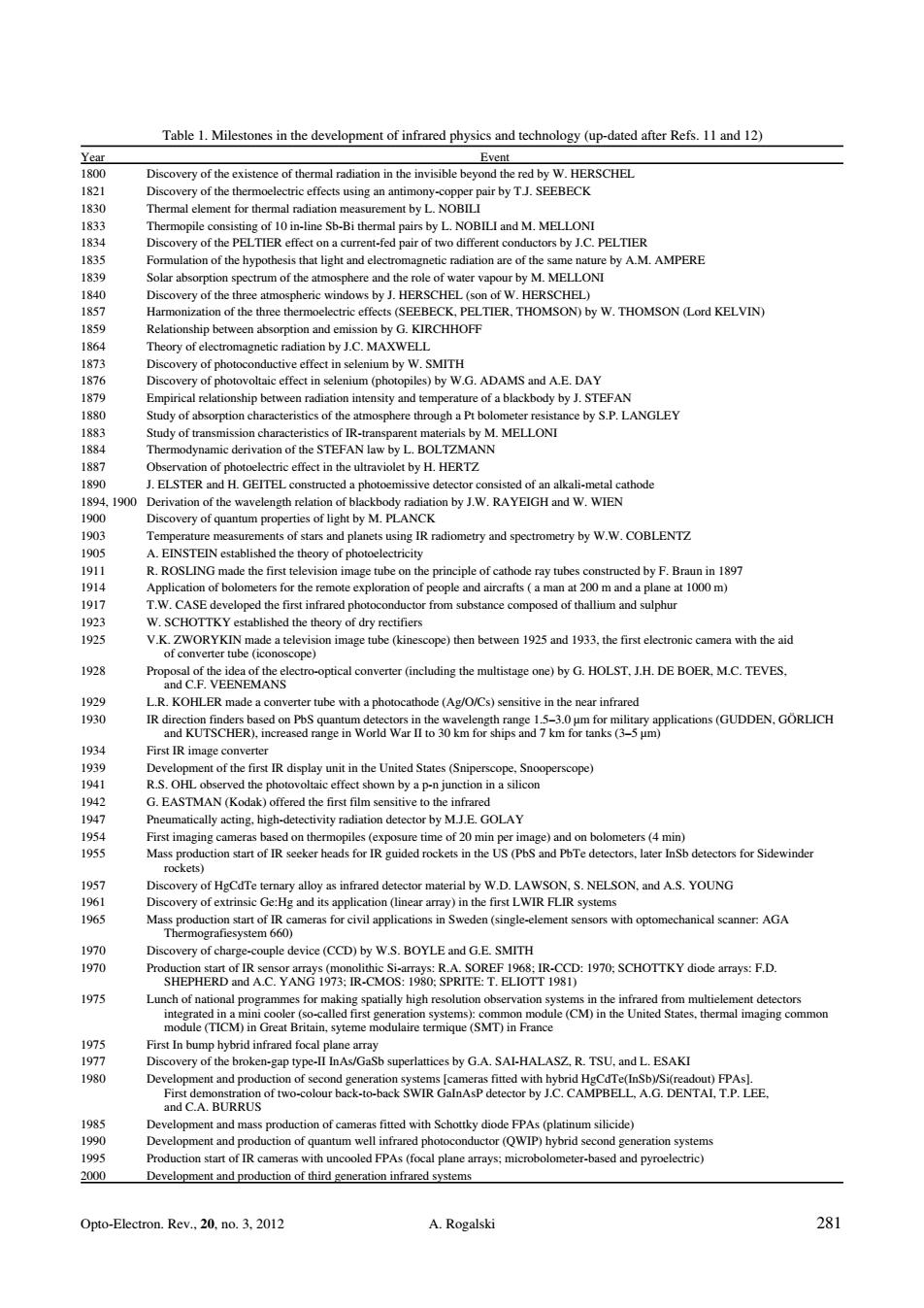正在加载图片...

Table 1.Milestones in the development of infrared physics and technology(up-dated after Refs.11 and 12) Event R air by TJ.SEEBECK SCHE of 10n-linSb-Bi ther 断 LT wnOON) he ic radiation by J.C.MAXWELL n of p c effect in the u olet by H.HERTZ or qu: 1903 ted by F.Braun in 1897 192 V.SCHOTTKY e)then be en 1925 and 1933,the first ith 1928 optical sonverter (including the multistage one)by G.HOLST.JH.DE BOER.MC.TEVES 1929 LR.KOHLER made a co r tube with a photocathode (A/o cs)sensitive in the pear infrared 1930 tof the firstIR n the United Sta 195 1955 (ing-eme anical scanner:AGA CCD)by WS.BOYLEandGESMIT SHEPERD CNGMO D1970.SCHOTTKY dode ayF.D. 1975 Lunch of national progran First In bur 1980 y G. t and pro on of cameras fitted with Schottky diode FPAs (platinum silicide) ment and 20 Development and production of third generation infrared system Opto-Electron.Rev.20.n.3.2012 A.Rogalski 281 Opto−Electron. Rev., 20, no. 3, 2012 A. Rogalski 281 Table 1. Milestones in the development of infrared physics and technology (up−dated after Refs. 11 and 12) Year Event 1800 Discovery of the existence of thermal radiation in the invisible beyond the red by W. HERSCHEL 1821 Discovery of the thermoelectric effects using an antimony−copper pair by T.J. SEEBECK 1830 Thermal element for thermal radiation measurement by L. NOBILI 1833 Thermopile consisting of 10 in−line Sb−Bi thermal pairs by L. NOBILI and M. MELLONI 1834 Discovery of the PELTIER effect on a current−fed pair of two different conductors by J.C. PELTIER 1835 Formulation of the hypothesis that light and electromagnetic radiation are of the same nature by A.M. AMPERE 1839 Solar absorption spectrum of the atmosphere and the role of water vapour by M. MELLONI 1840 Discovery of the three atmospheric windows by J. HERSCHEL (son of W. HERSCHEL) 1857 Harmonization of the three thermoelectric effects (SEEBECK, PELTIER, THOMSON) by W. THOMSON (Lord KELVIN) 1859 Relationship between absorption and emission by G. KIRCHHOFF 1864 Theory of electromagnetic radiation by J.C. MAXWELL 1873 Discovery of photoconductive effect in selenium by W. SMITH 1876 Discovery of photovoltaic effect in selenium (photopiles) by W.G. ADAMS and A.E. DAY 1879 Empirical relationship between radiation intensity and temperature of a blackbody by J. STEFAN 1880 Study of absorption characteristics of the atmosphere through a Pt bolometer resistance by S.P. LANGLEY 1883 Study of transmission characteristics of IR−transparent materials by M. MELLONI 1884 Thermodynamic derivation of the STEFAN law by L. BOLTZMANN 1887 Observation of photoelectric effect in the ultraviolet by H. HERTZ 1890 J. ELSTER and H. GEITEL constructed a photoemissive detector consisted of an alkali−metal cathode 1894, 1900 Derivation of the wavelength relation of blackbody radiation by J.W. RAYEIGH and W. WIEN 1900 Discovery of quantum properties of light by M. PLANCK 1903 Temperature measurements of stars and planets using IR radiometry and spectrometry by W.W. COBLENTZ 1905 A. EINSTEIN established the theory of photoelectricity 1911 R. ROSLING made the first television image tube on the principle of cathode ray tubes constructed by F. Braun in 1897 1914 Application of bolometers for the remote exploration of people and aircrafts ( a man at 200 m and a plane at 1000 m) 1917 T.W. CASE developed the first infrared photoconductor from substance composed of thallium and sulphur 1923 W. SCHOTTKY established the theory of dry rectifiers 1925 V.K. ZWORYKIN made a television image tube (kinescope) then between 1925 and 1933, the first electronic camera with the aid of converter tube (iconoscope) 1928 Proposal of the idea of the electro−optical converter (including the multistage one) by G. HOLST, J.H. DE BOER, M.C. TEVES, and C.F. VEENEMANS 1929 L.R. KOHLER made a converter tube with a photocathode (Ag/O/Cs) sensitive in the near infrared 1930 IR direction finders based on PbS quantum detectors in the wavelength range 1.5–3.0 μm for military applications (GUDDEN, GÖRLICH and KUTSCHER), increased range in World War II to 30 km for ships and 7 km for tanks (3–5 μm) 1934 First IR image converter 1939 Development of the first IR display unit in the United States (Sniperscope, Snooperscope) 1941 R.S. OHL observed the photovoltaic effect shown by a p−n junction in a silicon 1942 G. EASTMAN (Kodak) offered the first film sensitive to the infrared 1947 Pneumatically acting, high−detectivity radiation detector by M.J.E. GOLAY 1954 First imaging cameras based on thermopiles (exposure time of 20 min per image) and on bolometers (4 min) 1955 Mass production start of IR seeker heads for IR guided rockets in the US (PbS and PbTe detectors, later InSb detectors for Sidewinder rockets) 1957 Discovery of HgCdTe ternary alloy as infrared detector material by W.D. LAWSON, S. NELSON, and A.S. YOUNG 1961 Discovery of extrinsic Ge:Hg and its application (linear array) in the first LWIR FLIR systems 1965 Mass production start of IR cameras for civil applications in Sweden (single−element sensors with optomechanical scanner: AGA Thermografiesystem 660) 1970 Discovery of charge−couple device (CCD) by W.S. BOYLE and G.E. SMITH 1970 Production start of IR sensor arrays (monolithic Si−arrays: R.A. SOREF 1968; IR−CCD: 1970; SCHOTTKY diode arrays: F.D. SHEPHERD and A.C. YANG 1973; IR−CMOS: 1980; SPRITE: T. ELIOTT 1981) 1975 Lunch of national programmes for making spatially high resolution observation systems in the infrared from multielement detectors integrated in a mini cooler (so−called first generation systems): common module (CM) in the United States, thermal imaging common module (TICM) in Great Britain, syteme modulaire termique (SMT) in France 1975 First In bump hybrid infrared focal plane array 1977 Discovery of the broken−gap type−II InAs/GaSb superlattices by G.A. SAI−HALASZ, R. TSU, and L. ESAKI 1980 Development and production of second generation systems [cameras fitted with hybrid HgCdTe(InSb)/Si(readout) FPAs]. First demonstration of two−colour back−to−back SWIR GaInAsP detector by J.C. CAMPBELL, A.G. DENTAI, T.P. LEE, and C.A. BURRUS 1985 Development and mass production of cameras fitted with Schottky diode FPAs (platinum silicide) 1990 Development and production of quantum well infrared photoconductor (QWIP) hybrid second generation systems 1995 Production start of IR cameras with uncooled FPAs (focal plane arrays; microbolometer−based and pyroelectric) 2000 Development and production of third generation infrared systems